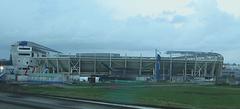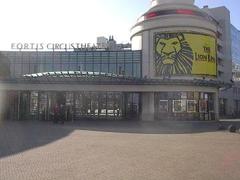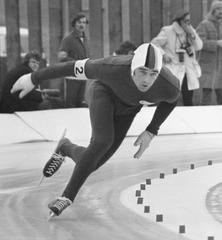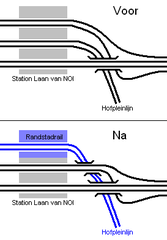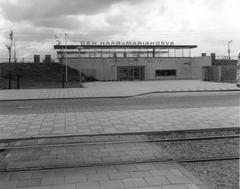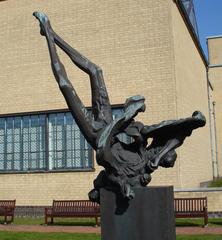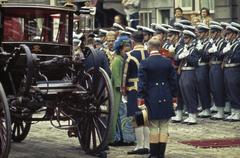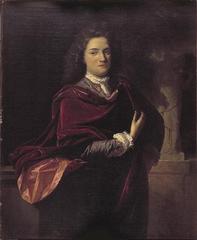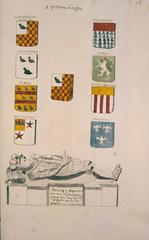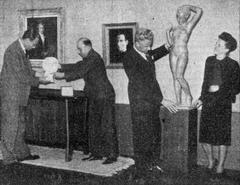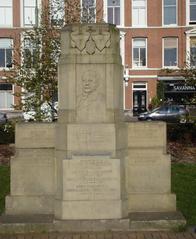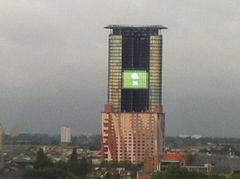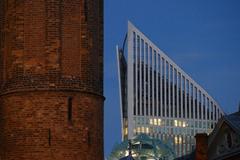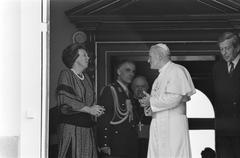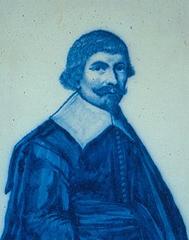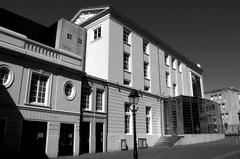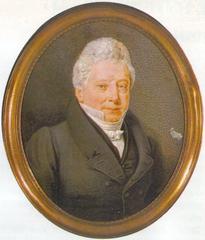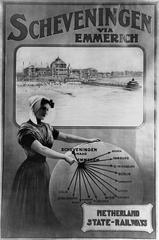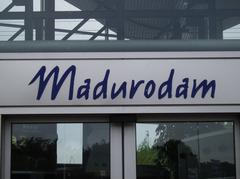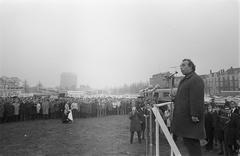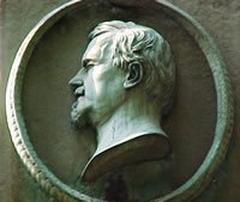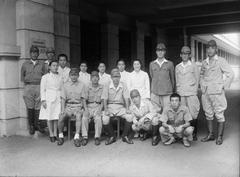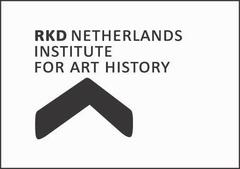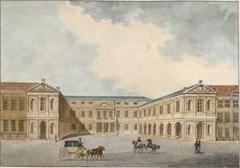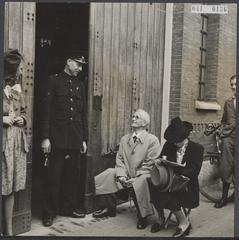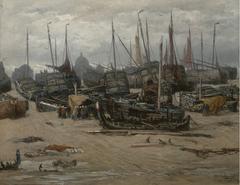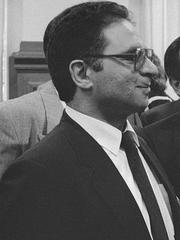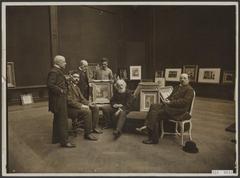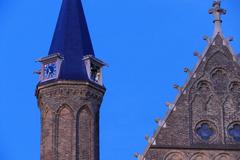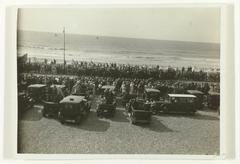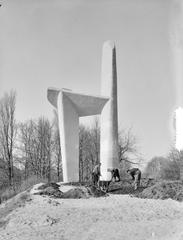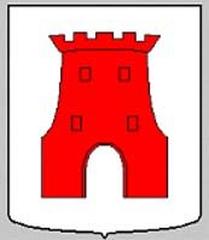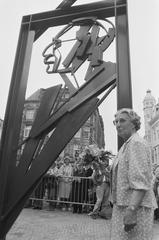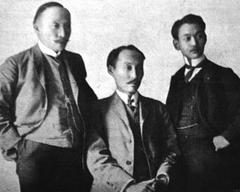
World Peace Flame The Hague: Visiting Hours, Tickets, and Historical Significance
Date: 04/07/2025
Introduction
The World Peace Flame in The Hague, Netherlands, stands as a powerful international symbol of hope, unity, and the enduring pursuit of peace. Inaugurated in 2002, this eternally burning flame was the first public “daughter” flame to originate from a unique global initiative that united flames from all continents. Situated directly beside the Peace Palace—home to the International Court of Justice—the monument invites visitors to reflect on humanity’s shared aspirations for harmony and justice. Encased in a striking granite pillar by Dutch artist Heleen van der Sande, and surrounded by the World Peace Pathway, the site offers a compelling blend of art, history, and international collaboration. This guide provides an in-depth look at the World Peace Flame’s origins, artistic design, practical visitor information (including hours, tickets, accessibility, and travel tips), and nearby historical sites to enrich your visit (Susan Ives, 2024; Life in The Hague, 2021; BKDH; World Peace Flame Foundation; Spotted by Locals).
Table of Contents
- Origins and Symbolism of the World Peace Flame
- Monument Design and the World Peace Pathway
- International Significance and Educational Impact
- Visiting Information
- Travel Tips and Accessibility
- Nearby Historical Sites and Attractions
- Frequently Asked Questions (FAQ)
- Conclusion
- Sources
Origins and Symbolism of the World Peace Flame
The World Peace Flame began as a visionary peace initiative in July 1999, uniting seven flames from all inhabited continents in Bangor, Wales. Spearheaded by peace advocates including Mansukh Patel and Savitri MacCuish, the act symbolized unity and hope across cultural and national boundaries. The original flame in Wales became the source for “daughter” flames distributed worldwide, with The Hague’s monument being the first to be permanently installed in a public space (Susan Ives, 2024; World Peace Flame Foundation).
The flame’s location beside the Peace Palace was a deliberate choice, reinforcing The Hague’s long-standing identity as the “International City of Peace and Justice.” Here, the monument stands not as a memorial to specific events, but as a perpetual call for peace, inclusivity, and shared responsibility among all peoples (Life in The Hague, 2021).
Monument Design and the World Peace Pathway
Artistic Vision
The World Peace Flame monument was designed by Dutch sculptor Heleen van der Sande (also referenced as Heleen van der Sanden - de Groot). The 160 cm-tall pillar is crafted from durable bahia azul granite and features a simple, minimalist inscription: “World Peace Flame.” At its heart, the eternal flame burns within a circular opening, emphasizing universality and endurance (BKDH).
The World Peace Pathway
Encircling the monument is the World Peace Pathway, inaugurated in 2004. This circular walkway is composed of 197 stones donated by countries and regions worldwide, many carrying unique geological or historical value. Notably, the pathway includes a fragment of the Berlin Wall (Germany) and a rock from Robben Island’s prison wall (South Africa), connecting the monument to pivotal global moments (Atlas Obscura; World Peace Flame Foundation).
Each stone is labeled with its country of origin, facilitating a tactile, educational journey “around the world.” The pathway’s completion marked the first time every UN-recognized country united in a collective statement for peace.
International Significance and Educational Impact
The World Peace Flame serves as both a physical monument and a dynamic center for peace education. Managed by the World Peace Flame Foundation, the site hosts workshops, school visits, community ceremonies, and events commemorating international peace days (WPF Annual Report 2023-2024, p. 6). The monument is frequently “adopted” by local schools, with children participating in message-writing, research, and poetry recitals that encourage reflection on peace, diversity, and global citizenship.
The monument’s inclusive philosophy is reinforced by its design: there are no commemorative plaques for individuals or isolated events. Instead, it stands as a universal invitation for all visitors to contemplate and contribute to the ongoing journey toward peace (BKDH).
Visiting Information
Location
- Address: Carnegieplein 2, 2517 KJ The Hague, Netherlands
- Setting: In front of the Peace Palace (Vredespaleis), within The Hague’s international district
Visiting Hours
- Monument and Pathway: Open 24 hours a day, year-round.
- Peace Palace Visitor Centre:
- Wednesday–Friday: 13:00–17:00
- Saturday–Sunday: 11:00–16:00
Tickets and Admission
- World Peace Flame: Free admission; no tickets required.
- Peace Palace Tours: Guided tours of the Peace Palace are rare and must be reserved in advance; virtual tours may be available (World Peace Flame Foundation).
- Donations: Contributions to the World Peace Flame Foundation are welcomed to support educational and peace initiatives.
Amenities
- Restrooms: Available at the Peace Palace Visitor Centre (during opening hours)
- Seating: Mosaic benches at the monument, crafted by local students
- Shops/Cafés: Numerous options nearby along Anna Paulownastraat and in The Hague city center
Travel Tips and Accessibility
- Public Transport:
- Tram lines 1 and 9 stop at “Vredespaleis,” just steps from the monument
- The Hague Central Station is a 10-minute tram ride or 20-minute walk away
- Parking: Limited street parking; public transport or cycling is recommended
- Wheelchair Accessibility: Entire site is wheelchair accessible with smooth, paved paths
- Best Times to Visit: Early mornings or late afternoons for a peaceful atmosphere and ideal lighting for photography; the monument is also quiet during weekdays
- What to Bring: Camera, notebook, and curiosity for self-guided exploration
Nearby Historical Sites and Attractions
- Peace Palace Gardens: Explore the landscaped gardens (may require advance booking)
- Madurodam: Interactive miniature park (20-minute walk)
- Binnenhof and Hofvijver: Dutch Parliament and historic lake (short tram ride or walk)
- Palace Garden (Paleistuin): Tranquil public park near Noordeinde Palace
- Scheveningen Beach: Lively pier, restaurants, and summer activities (accessible by tram)
- Chinatown: Diverse Asian dining and shopping
- Haagse Bos, Zuiderpark: Urban green spaces ideal for walking and family activities
- Nearby Cities: Delft, Leiden, and Rotterdam are all easily reached by train for day trips
Frequently Asked Questions (FAQ)
Q: What are the World Peace Flame visiting hours?
A: The monument is accessible 24/7, year-round.
Q: Is there an entrance fee or ticket required?
A: No, visiting the World Peace Flame is free of charge.
Q: Is the monument wheelchair accessible?
A: Yes, the monument and pathway are fully accessible.
Q: Are guided tours available?
A: Guided tours of the Peace Palace are limited and must be booked in advance. No official guides are provided at the monument, but self-guided tours are available via apps like GPSmyCity.
Q: What is the best time to visit for photography?
A: Early mornings or late afternoons, when the light is softer and the site is quieter.
Q: How do I get there by public transport?
A: Take tram lines 1 or 9 to the “Vredespaleis” stop, then walk a few steps to Carnegieplein.
Conclusion
The World Peace Flame in The Hague is a living emblem of hope, unity, and international cooperation. Its origins in a global peace initiative, the enduring eternal flame, and the encompassing World Peace Pathway reflect an unwavering commitment to inclusivity and shared humanity. The monument’s location beside the Peace Palace, in a city renowned for its dedication to justice, offers a serene and accessible environment for contemplation, learning, and community engagement.
Whether you are a local resident, history enthusiast, peace advocate, or international traveler, the World Peace Flame promises a meaningful and memorable experience. Plan your visit to participate in this living symbol of peace, and explore the rich heritage of The Hague with the help of the World Peace Flame Foundation and the Audiala app.
Sources
- Susan Ives, 2024
- Life in The Hague, 2021
- BKDH
- World Peace Flame Foundation
- Spotted by Locals
- Atlas Obscura
- World City Trail
- WPF Annual Report 2023-2024, p. 6
- GPSmyCity




